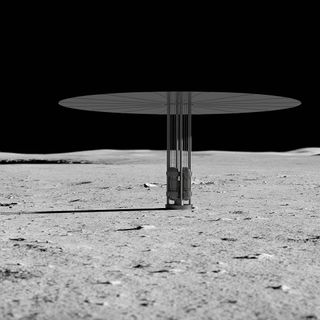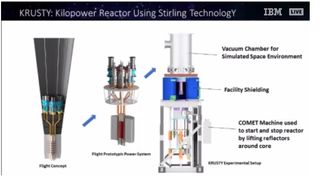A Nuclear Reactor for Space Missions Passes Final Major Ground Tests

Scientists, engineers and reporters gathered at NASA's Glenn Research Center in Cleveland on May 2 for a news conference announcing the latest results of the Kilopower nuclear power plant project: It has finished all of its major ground tests and met or surpassed the development team's expectations.
NASA is developing the experimental reactor to provide reliable energy for long-duration crewed missions to the moon, Mars and destinations beyond.
For decades, spacecraft have relied on nuclear power as a compact, reliable source of electricity, especially on missions for which solar power is not feasible, like expeditions to the moon's polar regions. The Voyager 1 and 2 spacecraft, which are now billions of miles from the sun, still have enough nuclear energy after more than 40 years to transmit signals back to Earth. Meanwhile, the Curiosity rover has been driving around the Red Planet for nearly six years courtesy of a trunk full of plutonium. [Nuclear Generators for NASA Deep Space Probes (Infographic)]
In spacecraft like the Voyagers and Curiosity, a device called a radioisotope thermoelectric generator (RTG) converts heat energy from passive radioactive decay directly into electricity. The decay causes a temperature difference across plates of two kinds of metal — one connected to the reactor, and the other attached to a radiator, thereby producing a voltage. This component, called a thermocouple, is commonly used in thermometers and temperature sensors. Although RTGs are not particularly efficient, they are simple and have no moving parts, making them perfect for applications in which repair is not an option.
But many future missions, especially those involving human crews, will require much more power than the RTGs can produce. That's why NASA and the U.S. Department of Energy (DOE) are collaborating to create a space-ready nuclear reactor, which harvests energy from active nuclear fission, or atom splitting.
At the news conference, NASA and DOE officials announced the completion of successful ground tests of the experimental reactor, called the Kilopower Reactor Using Stirling Technology (KRUSTY). The team tested the reactor at the DOE Nevada National Security Site in four phases. The first two were conducted without power, to ensure that the components reacted as expected. During the third phase, the team gradually increased power to heat the core. The final phase consisted of a 28-hour, full-power test that simulated an actual mission.
The team evaluated the reactor's startup sequence, steady state performance, efficiency and more. In each category, the test reactor met or exceeded the team's benchmarks, running at full power under vacuum conditions, according to Kilopower lead engineer Marc Gibson.
Get the Space.com Newsletter
Breaking space news, the latest updates on rocket launches, skywatching events and more!
"We threw everything we could at this reactor, in terms of nominal and off-normal operating scenarios, and KRUSTY passed with flying colors," said David Poston, chief reactor designer at the National Nuclear Security Administration's Los Alamos National Laboratory.

The significance of these results is hard to overstate, said Gibson. Research on space-ready fission reactors has been mired by high costs and lengthy time frames from the late 1970s to the early 2000s, which resulted in many canceled projects. "This is the first nuclear-powered operation of a new fission reactor concept in the U.S. in 40 years," Gibson said.
Fission reactors have many practical advantages over RTGs. For instance, RTGs generally produce only a few hundred watts, but the reactor is scalable to 10,000 watts. Four units could provide enough power to establish an extraterrestrial outpost, according to a statement NASA released after the event.
Another advantage is that, unlike an RTG, which runs continuously, a reactor's output can be tailored to current demands, Gibson said. That also means it can remain dormant during launch and travel and turn on once it reaches its destination. This ability, combined with the increased efficiency of fission reactors over RTGs, means that a Kilopower generator could maintain its 1-kilowatt output for at least 10 years, NASA officials said in the statement.
Self-regulation has been a crucial requirement in designing the reactor, according to Poston. This feature not only increases the safety of the reactor but also frees astronauts from having to monitor the controls. "We're not going to have operators there," Poston said. "And even if there are astronauts around, they're not going to be wanting to sit at a reactor control center the whole time." [NASA's Human Mars Mission Will Require Living Off the Land]

The system works like a thermostat, where feedback keeps the device at a preset temperature, Poston said. If the reactor overheats, the Stirling engines that produce electricity draw more heat from the uranium core. If it is too cool, the core naturally contracts, trapping more free neutrons, which then increases the rate of fission.
Responding to concerns over Russia's recently launched, floating nuclear power plant, Poston explained that the reactor will pose little or no risk to the public. NASA follows all relevant protocols, including those set out by the United Nations, he said. Additionally, the reactor will not be turned on until it is far away from Earth. "We've done calculations to show that, under all worst-case conditions, we don't believe that there's any chance the reactor would come on accidentally, [even] during a launch accident," Poston said.
The team has also considered safety at the reactor site. Engineers at NASA's Johnson Space Center are designing containers to safely store spent fuel on-site, since returning it to Earth would not be practical, said Patrick Cahalane, the principal deputy associate administrator for safety, infrastructure and operations at the National Nuclear Security Administration. The reactors have no radioactive coolant that would pose a contamination risk, and the development team is researching mechanisms to shield astronauts from radiation that the reactor may emit, including building in protection and burying part of the reactor under the surface.
Although the prototype isn't the same as units that will be deployed into space, it was designed with the flight-unit in mind, Gibson said. Flight tests are the next major step in development, though NASA has yet to plan them.
The Kilopower generator is optimized for use on surface missions, but officials at the news conference said it could also be used to power ion propulsion systems or be included on the Lunar Orbital Platform-Gateway, a proposed outpost for astronauts positioned in the space near Earth's moon.
Follow Harrison Tasoff @harrisontasoff. Follow us @Spacedotcom, Facebook and Google+. Original article on Space.com.
Join our Space Forums to keep talking space on the latest missions, night sky and more! And if you have a news tip, correction or comment, let us know at: community@space.com.

Harrison Tasoff is a science journalist originally from Los Angeles. He graduated from NYU’s Science, Health, and Environmental Reporting Program after earning his B.A. in mathematics at Swarthmore College. Harrison covers an array of subjects, but often finds himself drawn to physics, ecology, and earth science stories. In his spare time, he enjoys tidepooling, mineral collecting, and tending native plants.